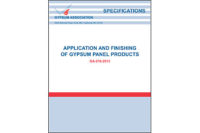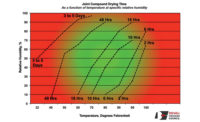I first heard of “pre-rocking” when I joined the Gypsum Association in the early 1990s. Apparently the practice, what the contracting community sometimes called “rock above,” had been around since at least the 1980s, and was used mainly within the non-residential construction sector. At first, the concept of installing gypsum panels before the building was dried-in made no sense to me. Once I learned more, I quickly caught on.
Pre-rock is the practice of installing gypsum panel products as early as possible in the construction process. Installing the gypsum panels first allows other trades to cut through the properly applied, attached, and finished gypsum panels and partitions leaving only the penetrations to be protected and treated as necessary. This not only saves construction time, it also ensures a better quality, code compliant gypsum panel application.
Early panel installation also simplifies the joint staggering process. Piecing gypsum panels around equipment and supports creates unbacked joints and makes fastener installation awkward. During pre-rock, the working space is free of obstructions and panels can be installed to comply with the requirements of a specific fire or sound-rated design. Joints and fasteners are also easier to access for finishing.
When I joined a member company firm a few years later, I witnessed the steady rise of pre-rocking as a viable means of speeding the construction schedule, and reducing cost while creating a high quality finish. In these days of increasingly integrated delivery methods, pre-rocking is bound to expand into many construction sectors. Those who work closely with the design community might consider promoting the practice as a means of accelerating project completion. Pre-rocking within a design-build scenario or a Lean Design and Construction project is an option that should be given serious consideration by all parties involved.
Three Primary Precautions
First, because pre-rocking generally commences very early in the construction sequence, it often necessitates installing gypsum panels before the building is enclosed or weather-tight and “dried in.” This generally causes the gypsum panels to be installed in locations where they will be exposed to moisture or high humidity. Gypsum panel products should not be installed on ceilings or any horizontal applications in pre-rock conditions where the potential for ponding water may occur.
To create an acceptable finished surface and to ensure proper system performance, gypsum panel products that are specifically designed for use in high moisture or humidity areas should be specified, stocked, and installed when panels are installed in a pre-rock environment. This means installing something other than traditional, paper-faced gypsum wallboard. Special precautions must be taken to avoid mold, moisture and other water related issues that could occur during construction, later in the project or even after occupancy.
A number of gypsum panel products are specifically designed for pre-rock applications. Available from most gypsum manufacturers, they are either glass mat faced gypsum panels or fiber reinforced gypsum panels. These products have both treated facers and cores for added moisture and mold resistance while offering up to a 12 month exposure time to the elements. It is always recommended to contact the manufacturer for details but these high performance panels should be used in pre-rock applications.
The Second Precaution
Second, all the requirements of the applicable fire or sound-rated assembly design must be fully incorporated into the finished construction. This may require installing, or at a minimum laying-out, the panels on the exposed side of a pre-rocked partition so that the horizontal and vertical joints are staggered as specified in the listing or design description.
Furthermore, while explanatory language in the Fire Resistance Design Manual, GA-600,as well as some building code language, does permit specific fire-resistance rated constructions to be installed without finished joints, the same language generally does not apply to sound attenuating systems. Since most walls in a pre-rock situation serve as both fire-rated and sound attenuating systems, the system should be finished to comply with the most stringent requirement from either the fire- or sound-rated design.
And Last but Not Least …
The third requirement is that the core type and thickness of board or panel used in the system must be identical to that described in the fire or sound-rated design description. While this is consistent with the requirements for all tested systems, the concept bears discussion because of the unique nature of pre-rock systems.
System descriptions typically identify the baseline panel that was used in the fire test but do not identify alternate products that may be used as substitutes. For example, an often-installed 2-hour noncombustible wall such as WP 1616 in the FRDM describes the installed panels as two layers of “5/8-inch type X gypsum wallboard or gypsum veneer base” on each side of steel studs.
Such a statement would seem to be at odds with our first requirement, for the description does not identify a specialty product as an acceptable facing for the tested system. Relief is provided by language in an ICC-ES Evaluation Report sponsored by the Gypsum Association, ESR-1338,which permits “… boards … of the same size, thickness, and core type …” to be used in fire-rated and sound attenuating systems.
To comply, the system must be constructed with a panel size that will permit compliance with the joint staggering and fastener spacing requirements of the fire or sound-rated system description. It must also possess an equivalent thickness and core type as the panel described in the test. For example, in the instance of WP 1616 a 5/8-inch-thick, type X core, mold and moisture-resistant panel could be substituted for the gypsum wallboard described in the system. A 1/2-inch-thick panel would not comply. Maintaining consistency with one panel manufacturer is also advised.
Accelerated project schedules make pre-rocking a logical practice in virtually every construction exposure. It is a very useful technique that can save time and eliminate many of the obvious problems associated with attempting to install gypsum panels after the electrical, mechanical and plumbing equipment and services are in place. Panel manufacturers provide a bevy of information on the products to incorporate into pre-rock construction and many of the new panels are ideal for use during the early stages of a project.
Top Down Construction
Pre-rocking is sometimes referred to as “top down construction,” “topping out,” or other terms that are geographic or regional in nature. These other terms can have one or more meanings throughout the country and this can cause confusion and misunderstandings on a jobsite. Gypsum manufacturers prefer the term “pre-rocking” which often occurs before the building is dried-in and prior to standard gypsum wallboard installation.






